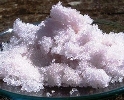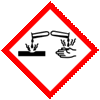Search for the supplies that you need here:
DMF Support and Documentations Available |
|||
 WHO-GMP Certified Good Manufacturing Practice Certified by World Health Organization |
 WC, Written Confirmation for Active Substance to be imported into European Union (EU). |
||
Iron Nitrate or Ferric Nitrate Nonahydrate SDS MSDS Sheet of Manufacturers
Anmol Chemicals is a manufacturer supplier exporter of Iron Nitrate or Ferric Nitrate Nonahydrate and it offers materials as per IP BP EP Ph Eur USP NF JP FCC Food Grade as per the the latest monograph at best prices. Anmol Chemicals Group, established in 1976, is the pioneer manufacturer of Specialty Chemicals, Pharmaceutical Excipients, Some API, Food Chemicals in India. Anmol Chemicals Group has manufacturing facilities spread across Western India, representatives in Houston, Chicago USA and Dubai, UAE. We also have toll manufacturing units for processing chemicals in a few countries around the world. We make IP, BP, EP, USP, NF, Ph. Eur., JP, FCC or Food Grade, Analytical Reagent Grade, LR or Laboratory Reagent Grades and Pure Grades of various chemicals. All our items are analyzed to meet the required standards. We can supply the product in grams for your laboratory trial and in tons for your plant scale jobs.
We manufacture Bulk Drugs / API, Excipients, Pharmaceuticals (IP BP USP NF Ph Eur EP JP), Specialty Chemicals (Pure/Reagent), Mineral Fortifiers (FCC). Our manufacturing facility is FDA approved and GLP, cGMP, ISO9001, ISO14001, ISO/IEC 17025, ISO22000, FSSC 22000, ISO45001, FSSAI, Kosher, HALAL, COPP, WHO-GMP certified and Written Confirmation (WC) is available. Solid materials can be customized for particle size, shape, and bulk density. We observe WHO Good Manufacturing Practices and Good Laboratory Practices. We are a government-recognized STAR Export House and "Authorised Economic Operator (AEO)" per Indian Customs.
All technical documents and DMF support available.
Iron Nitrate or Ferric Nitrate Nonahydrate Specifications of Manufacturers

Ferric Nitrate Nonahydrate or Iron Nitrate Nonahydrate SDS Safety Data Sheet
MSDS Sheet, Material Safety Data Sheet
Section 1: Product Identification
Product Name & Other Names: Ferric Nitrate Nonahydrate or Iron Nitrate Nonahydrate.
CAS No.: 7782-61-8
EINECS EC Number: 233-899-5
Molecular Weight: 404.00
Chemical Formula: Fe(NO3)-9H2O
Relevant uses and uses advised against (if any): Laboratory chemicals, Manufacture of substances. For Industrial use.
Details of the supplier: As per letter head.
Section 2: Hazard Identification
GHS, Globally Harmonized System Classification in accordance with 29 CFR 1910
Classification according to Regulation (EC) No 1272/2008
Corrosive to Metals Category 1
Skin corrosion/irritation Category 1A, B, C
Labeling according Regulation (EC) No 1272/2008
GHS Label Elements  Corrosive |
Signal Words: Danger
Hazard statements:
H290: May be corrosive to metals
H314: Causes severe skin burns and eye damage.
Precautionary statements:
P234: Keep only in original container.
P260: Do not breathe dust/fume/gas/mist/vapors/spray.
P264: Wash --- thoroughly after handling.
P280: Wear protective gloves/protective clothing/eye protection/face protection.
P362: Take off contaminated clothing and wash before reuse.
P303+361+353: IF ON SKIN (or hair): Remove/Take off immediately all contaminated clothing. Rinse skin with water/shower.
P305+351+338: IF IN EYES: Rinse cautiously with water for several minutes. Remove contact lenses if present and easy to do – continue rinsing.
Classification according to EU Directives 67/548/EEC or 1999/45/EC:
Hazard Symbol:
C Corrosive.
Risk Phrases:
R34 Causes burns.
R41 Risk of serious damage to eyes.
Section 3: Composition / Information on Ingredients
Product Name & Other Names: Ferric Nitrate Nonahydrate or Iron Nitrate Nonahydrate.
CAS No.: 7782-61-8
EINECS EC Number: 233-899-5
Section 4: First Aid Measures
Always seek medical attention after first aid measures are provided.
Eye Contact: Check for and remove any contact lenses. In case of contact, immediately flush eye with plenty of water for at least 15 minutes. Cold water may be used. Get medical attention immediately.
Skin Contact: Immediately flush skin with plenty of water for at least 15 minutes while removing contaminated clothing and shoes. Call a physician, immediately. Wash clothing before reuse.
Ingestion: If swallowed, do not induce vomiting unless directed to do so by medical personnel. Never give anything by mouth to and unconscious person. Loosen tight clothing such as a collar, tie, belt, or waistband. Get medical attention immediately.
Inhalation: If breathed in, move person into fresh air. If not breathing, give artificial respiration. Consult a physician.
Section 5: Fire Fighting Measures
Flash Point: NA
Fire Extinguishing Media: Adapt extinguishing media to the environment. Use water spray, alcohol-resistant foam, dry chemical, or carbon dioxide.
Special Fire Fighting Procedures: Wear self contained breathing apparatus for firefighting if necessary.
Hazardous combustion products: Nitrogen oxides (NOx), Iron oxides.
Section 6: Accidental Release Measures
Personal precautions, protective equipment, and emergency procedures: Ventilate area of leak or spill. Avoid breathing dust/fumes/gas/mist/vapors/spray. Use individual protective equipment (waterproof boots, suitable protective clothing, safety glasses, etc.). Restrict unprotected personnel from the area. Prevent any contact with hot surfaces. Do not approach facing the wind. Do not touch the spilled material.
Environmental precautions: Do not let the product enter drains, soil, or water sources.
Methods and materials used for containment Cleanup procedures and Storage: Contain spilled material. Cover with an inert, non-combustible absorbent material, (e.g. sand, earth, diatomaceous earth, vermiculite). Vacuum or sweep-up and remove to an approved disposal container. Finish cleaning by spreading water on the contaminated surface and allow to evacuate as per law.
Section 7: Handling and Storage
Precautions for safe handling: Apply according to good manufacturing and industrial hygiene practices. Ensure proper ventilation. In case of insufficient ventilation, wear suitable respiratory equipment. Wash thoroughly after handling. Do not drink, eat, or smoke while handling. Avoid contact with skin, eyes, and clothing. Minimize dust generation. Avoid breathing dust/fumes/gas/mist/vapors/spray. Avoid contact with eyes, skin, and clothing. Keep container tightly closed. Avoid ingestion and inhalation. Use individual protective equipment (waterproof boots, suitable protective clothing, safety glasses, etc.). Prevent any contact with hot surfaces.
Conditions for safe storage, including any incompatibilities: Store in cool, dry, and ventilated area away from heat sources and protected from sunlight in tightly closed original container. Keep air contact to a minimum. Store protected from heat, sparks and ignition sources and incompatible materials. Avoid contact with skin and eyes. Avoid inhalation of dust/mist/vapor. Do not store with incompatible materials like strong oxidizing agents, organic matter, reducing agents, and moisture.
Section 8: Exposure Controls / Personal Protection
Components with workplace control parameters:
ACGIH TWA (mg/m³) 1 mg/m³ as Fe
NIOSH REL (TWA) (mg/m³) 1 mg/m³ as Fe
Engineering Controls Ventilation required.
Personal Protection Equipment
Respiratory protection: If workplace exposure limit (s) of product or any component is exceeded (see TLV/PEL), a NIOSH/MSHA approved air supplied respirator is advised in absence of proper environmental control. OSHA regulations also permit other NIOSH/MSHA respirator (negative pressure type) under specified conditions (see your safety equipment supplier). Engineering and/or administrative controls should be implemented to reduce exposure.
Protective gloves: Nitrile or equivalent.
Skin protection: Impervious, protective clothing.
Eye protection: Safety glasses with side shields must be worn at all times.
Additional clothing and/or equipment: Eyewash and safety equipment should be readily available.
Handle in accordance with good industrial hygiene and safety practice. Wash hands before breaks and at the end of workday.
Section 9 Physical and Chemical Properties
Appearance: Crystalline solid.
Odor: Odorless.
Odor threshold: Not available.
pH: 1.5 @20C
Relative density: around 1.68
Boiling Point: Decomposes.
Melting Point: 47C
Flash point: Not available.
Auto-ignition temperature: Not available.
Decomposition temperature: Not available.
Upper/lower flammability or explosive limits: Not available.
Vapor pressure: Not available.
Vapor density: Not available.
Evaporation rate: Not available.
Flammability (solid, gas): Not available.
Partition coefficient: n-octanol/water: Not available.
Solubility: Soluble in water.
Viscosity: Not available.
Molecular Weight: 404.00
Chemical Formula: Fe(NO3)-9H2O
Oxidizing properties: May intensify fire; oxidizer.
Section 10: Stability and Reactivity
Stability: Stable under ordinary conditions of use and storage. Very hygroscopic.
Reactivity: Not significant.
Conditions to Avoid: Contact with heat, light, combustible material, organic matter, reducing agents, powdered metals.
Hazardous Decomposition Products: Nitrogen oxides (NOx), Iron oxides.
Hazardous Polymerization: Will not occur.
Section 11: Toxicological Information
Results of component toxicity test: LD50 Oral - Rat - 3,250 mg/kg.
Carcinogenicity: No component of this product present at levels greater than or equal to 0.1% is identified as possible or confirmed human carcinogen by IARC, ACGIH, OSHA and NTP.
Mutagenic Effects: Not available.
Teratogenic Effects: Not available.
Developmental Toxicity: Not available.
Reproductive Effects: No information available.
Section 12: Ecological Information
Toxicity to fish: Not available.
Results of PBT and vPvB assessment: This substance/mixture contains no components considered to be either persistent, bioaccumulative and toxic (PBT), or very persistent and very bioaccumulative (vPvB) at levels of 0.1% or higher.
Section 13 Disposal Considerations
Offer surplus and non-recyclable solutions to a licensed disposal company. Dissolve or mix the material with a combustible solvent and burn in a chemical incinerator equipped with an afterburner and scrubber. Contaminated packaging must be disposed of as unused product.
Section 14: Transportation Information
US DOT & ADR/RID:
Proper shipping name: CORROSIVE SOLID, ACIDIC, INORGANIC, N.O.S. Ferric Nitrate Nonahydrate
Hazard Class: 8, Packaging group: II, UN Number: UN1466
IATA:
Proper shipping name: CORROSIVE SOLID, ACIDIC, INORGANIC, N.O.S. Ferric Nitrate Nonahydrate
Hazard Class: 8, Packaging group: II, UN Number: UN1466
IMO:
Proper shipping name: CORROSIVE SOLID, ACIDIC, INORGANIC, N.O.S. Ferric Nitrate Nonahydrate
Hazard Class: 8, Packaging group: II, UN Number: UN1466
Section 15: Regulatory Information
USA:
Sara 311/312: Immediate Health Hazard, Chronic Health Hazard. See section 2.
SARA 313: This material does not contain any chemical components with known CAS numbers that exceed the threshold (De Minimis) reporting levels established by SARA Title III, Section 313.
SARA 302: No chemicals in this material are subject to the reporting requirements of SARA Title III, Section 302.
California Prop 65 Components: This product does not contain any chemicals known to the State of California to cause cancer, birth, or any other reproductive defects.
Disclaimer:
**************************
Our company provides this MSDS sheet in good faith but makes no representation as to its comprehensiveness or accuracy. This SDS sheet is intended only as a guide to the appropriate precautionary handling of the material by a properly trained person using this product. The above information has been compiled from various sources and has the possibility of discrepancy and being out-dated information. Individuals receiving the information must exercise their independent judgment and do further search in determining its appropriateness for a particular purpose. In no case shall our company be liable to loss or damages by the product user.
**************************



Manufacturers
ANMOL CHEMICALS Private Limited
Representatives in Houston, Chicago and New York, USA
TEL: (OFF) +91 22 23726950, +91 22 23774610, +91 22 23723564
Taloja Navi Mumbai, Banglore, INDIA
e-mail: info@anmol.org
Copyright and Usual Disclaimer is Applicable
Last updated
22-feb-25
Exporters to USA, Canada, UAE, Kwait, Qatar, Gautemala, Tunisia, Europe, South Africa, Bangladesh, Sri Lanka, Tanzania, Kenya, Egypt, Iraq, Turkey, Israel, Vietnak, Nigeria, Uganda, Brazil, Chile, Argentina, Dubai, UAE, Saudi Arabia, Cameroon, Mexico, Brazil, Chile, Argentina, Korea, Thailand, Malaysia, Indonesia, Jakarta, Australia, China, Germany, France, etc.
Representatives in New York, Houston - Texas, Chicago - Illinois, Los Angeles.
All products are Sold for Industrial and Laboratory Use only. No other use is permitted.
Fast Selling IP BP Ph Eur EP USP NF JP Analytical Reagent FCC Food Grades of Chemicals by Anmol Chemicals
Ammonium Persulfate --- Acetic Acid Glacial --- Aluminum Chloride --- Ammonium bicarbonate --- Benzyl Alcohol --- Butylated Hydroxyanisole --- Butylated Hydroxytoluene --- Boric Acid --- Calcium Butyrate --- Calcium Chloride --- Calcium Hydroxide --- Calcium Lactobionate --- Calcium Saccharate --- Carbamide Peroxide --- Calcium Oxide --- Calcium Sulfate --- Chromic Chloride --- Fumaric Acid --- Magnesium Butyrate --- Magnesium Chloride --- Magnesium Sulfate --- Malic Acid --- Maleic Acid --- Manganese Chloride --- Manganese Sulfate --- Octyldodecanol --- Oleic acid --- Phenylethyl Alcohol --- Propylene Carbonate --- Potassium Hydroxide Pellets --- Potassium Alum --- Selenious Acid --- Sodium Acetate --- Sodium Bromate --- Sodium Selenite --- Sodium Perborate --- Sodium Hydroxide --- Sodium Sulphate --- Sodium Sulfide --- Sodium Thiosulfate --- Urea --- Zinc Chloride --- Zinc Sulphate ---


















